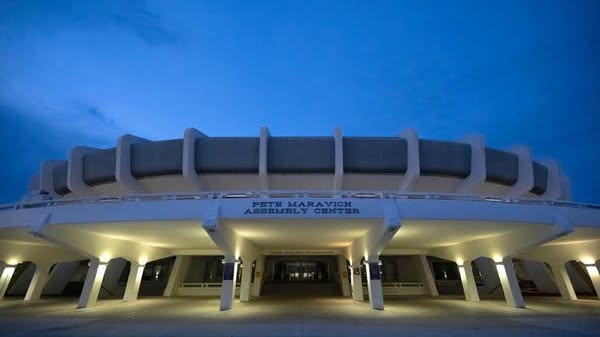BATON ROUGE, LA – In a bold and historic move, Louisiana State University (LSU) has announced a sweeping $768 million renovation project for the Pete Maravich Assembly Center (PMAC), marking the most significant investment in the university’s athletic infrastructure in its 164-year history. The renovation is aimed at modernizing the iconic 13,215-seat multi-purpose arena while preserving its storied legacy at the heart of Tiger athletics and entertainment.
A New Era Begins for an Iconic Structure
For over five decades, the PMAC has served as the home court for LSU men’s and women’s basketball, gymnastics, and countless campus and cultural events. Named after LSU basketball legend “Pistol” Pete Maravich, the arena has become a symbol of pride not just for the university, but for the entire state of Louisiana. Now, it’s set to undergo a massive transformation that will elevate it into one of the premier athletic and event venues in the country.
“This is more than a renovation,” said LSU President William F. Tate IV. “This is a reimagining of what the Pete Maravich Assembly Center can be—not only for our student-athletes and fans, but for the entire LSU community. We are building a world-class arena that reflects the excellence of LSU Athletics, our university, and the great state of Louisiana.”
Project Scope: Blending Legacy with Innovation
The $768 million renovation will be comprehensive, with upgrades spanning every inch of the facility. Among the key highlights of the project:
- Complete Interior Redesign: The arena bowl will be completely reconstructed to enhance sightlines and spectator comfort. New seating will include luxury suites, loge boxes, premium club levels, and a significant upgrade to general admission seats.
- Fan Amenities: Expanded concourses, new concession stands, family-friendly zones, state-of-the-art video boards, and sound systems will transform the fan experience.
- Athlete Facilities: New locker rooms, strength and conditioning centers, recovery and sports medicine spaces, and team lounges will be built to meet or exceed SEC and national standards.
- Technology Integration: The PMAC will feature immersive digital displays, interactive fan engagement areas, and 5G connectivity throughout the facility.
- Environmental Sustainability: The project includes LEED Gold certification goals, ensuring the renovated PMAC will operate with significantly reduced environmental impact.
- Preserving the Past: Statues, memorabilia, and architectural elements commemorating LSU legends like Pete Maravich, Seimone Augustus, Sylvia Fowles, and others will be prominently preserved and honored within the new design.
Financing the Future
The $768 million renovation will be funded through a combination of private donations, university capital funds, naming rights, and strategic public-private partnerships. LSU Athletics Director Scott Woodward emphasized the financial model is designed to protect taxpayers and ensure long-term sustainability.
“We are committed to funding this project responsibly,” Woodward said. “Our fundraising efforts have already begun in earnest, and the response has been incredible. The PMAC is a sacred place for so many Tiger fans, and now, they have an opportunity to be part of its transformation.”
Naming rights for the facility and various internal areas—including the court, clubs, and training centers—are expected to attract high-value partnerships. Additionally, the university will launch a “Forever PMAC” capital campaign to invite alumni and fans to contribute to legacy projects within the renovation.
Timeline and Phased Construction
Construction is set to begin in early 2026, with completion expected by the fall of 2028. To minimize disruptions to ongoing athletic seasons, the renovation will be completed in carefully coordinated phases:
- Phase 1 (2026): Infrastructure upgrades including plumbing, electrical systems, and structural reinforcement.
- Phase 2 (2026–2027): Reconstruction of the arena bowl and installation of new seating and fan amenities.
- Phase 3 (2027–2028): Athlete and team areas, external landscaping, and final system testing.
During construction, LSU teams will continue to compete at the PMAC, although temporary relocations or reduced seating may occur during peak construction periods.
Impact on LSU Athletics and Recruiting
The announcement has already sent a ripple effect across the college sports landscape. Coaches from LSU men’s and women’s basketball, gymnastics, and volleyball programs praised the plans, citing the renovation as a game-changer for recruiting and player development.
“I’m fired up,” said LSU men’s basketball coach Matt McMahon. “Facilities matter. When you walk a recruit into a place like this, it speaks volumes about our commitment to excellence.”
LSU women’s basketball head coach Kim Mulkey echoed that sentiment. “We’ve already made history in the PMAC, but now we’re building for the next 50 years of greatness. Our fans deserve the best. Our players deserve the best. And now, we’re going to deliver the best.”
The gymnastics program, which has seen record-breaking crowds and national recognition, also stands to benefit tremendously. “It’s a dream,” said head coach Jay Clark. “LSU is doubling down on its investment in women’s sports, and this facility will be a beacon for the SEC and the NCAA.”
Community and Economic Benefits
Beyond athletics, the renovated PMAC is expected to be a significant economic engine for Baton Rouge and the surrounding region. According to early estimates from LSU’s Economic Development Center, the project will create over 1,500 construction jobs and contribute more than $400 million in direct and indirect economic impact during the renovation period alone.
Once completed, the upgraded arena will attract major concerts, conferences, and national sporting events, further solidifying Baton Rouge as a cultural and economic hub in the South.
“Imagine bringing NCAA tournament games, gymnastics championships, or top-tier concert tours to a facility like this,” said Baton Rouge Mayor-President Sharon Weston Broome. “This project isn’t just for LSU—it’s for the city, the region, and the future.”
Honoring Pete Maravich and LSU Legacy
A key aspect of the renovation is ensuring that the legacy of Pete Maravich and the historical moments of LSU athletics remain central to the PMAC’s identity.
A new Maravich Legacy Atrium will be constructed at the main entrance, featuring interactive exhibits, memorabilia, and a 360-degree theater showcasing highlights of his legendary career. Statues of Maravich, Seimone Augustus, and other LSU greats will greet fans as they enter, making the PMAC not just a venue, but a living museum of Tiger pride.
“We want to celebrate the past while launching into the future,” said Woodward. “Pete Maravich is not just a name on a building—he’s the spirit of what we’re striving for.”
Fan Reactions and What’s Next
The response from Tiger Nation has been overwhelmingly positive. On social media and message boards, alumni and fans are sharing memories of PMAC games and voicing excitement for what’s to come.
“This is long overdue,” one fan posted on TigerDroppings. “The PMAC was legendary in its time, but it needs a serious upgrade. I’m thrilled to see LSU stepping up.”
The next step for the university will be finalizing architectural designs and opening formal bids for construction and project management. Renderings and virtual walkthroughs will be unveiled during LSU’s 2025 football season to build momentum and public engagement.
A dedicated project website and social media handles under the hashtag #ForeverPMAC will track the renovation’s progress, engage fans, and host fundraising events and digital campaigns.
As LSU embarks on this transformative journey, the Pete Maravich Assembly Center will stand as a symbol of ambition, legacy, and the relentless pursuit of greatness. It’s more than bricks and beams—it’s about setting a standard that matches LSU’s rich tradition of excellence.
“This project says everything about who we are and who we want to be,” said President Tate. “Bold, proud, and forward-thinking. The PMAC will not only continue to be the heart of LSU—it will beat stronger than ever.



